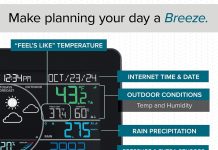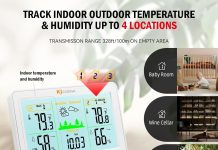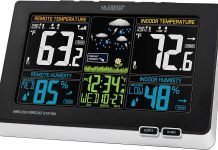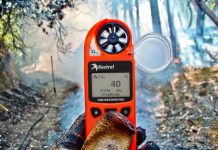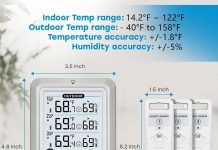Curious minds often ponder whether it is possible to view their home weather station data on their computer. In a world driven by technology, the desire to effortlessly access and analyze weather data from the comfort of one’s own screen is an enticing prospect. The good news is that this dream can indeed become a reality, with a myriad of options available to enable users to conveniently interact with their home weather station data on their computers. From dedicated software programs to online platforms, the possibilities are endless, empowering individuals to immerse themselves in the fascinating realm of meteorology, all with the click of a button.
Review contents
Connecting your home weather station to your computer
Determining compatibility
Before connecting your home weather station to your computer, it is important to first determine if they are compatible. Check the specifications of your weather station and ensure that it supports connection to a computer. Look for information regarding supported operating systems and connection methods.
Choosing a connection method
Once you have determined compatibility, the next step is to choose a connection method. There are various ways to connect your home weather station to your computer, including wired and wireless options. Consider factors such as convenience, range, and reliability when making your decision.
Installing software or drivers
To establish a connection between your weather station and computer, you will likely need to install software or drivers. The manufacturer of your weather station may provide dedicated software specifically designed for their product. Follow the instructions provided by the manufacturer to install the necessary software or drivers onto your computer.
Establishing a connection
After installing the required software or drivers, you can now establish a connection between your home weather station and computer. Connect the appropriate cables or configure the wireless settings according to the instructions provided by the manufacturer. Once the connection is established, your computer should be able to receive weather data from your weather station.
Accessing weather data on your computer
Using manufacturer-provided software
Many home weather stations come with their own software that allows you to access and view weather data on your computer. This software often provides a user-friendly interface where you can see real-time weather data, historical data, and even set up notifications and alerts. Check the documentation provided by the manufacturer for instructions on how to use the software effectively.
Utilizing weather station apps
In addition to manufacturer-provided software, there are also weather station apps available for various operating systems. These apps can be downloaded onto your computer and provide a convenient way to access and monitor weather data from your home weather station. Explore different app options and choose one that suits your needs and preferences.
Connecting to weather data providers
Some weather stations allow you to connect to weather data providers and access their extensive databases. By connecting your home weather station to a data provider, you can access not only your own weather data but also compare it with data from nearby weather stations or historic weather patterns. This can provide valuable insights and enhance your understanding of local weather conditions.
Setting up a cloud-based platform
Another way to access weather data on your computer is by setting up a cloud-based platform. Many weather stations offer cloud storage options where your weather data is automatically uploaded and stored. This allows you to access your data from any device with an internet connection, including your computer. Check if your weather station supports cloud storage and follow the instructions to set it up.
Accessing through a web browser
If your weather station has a built-in web server or can connect to a web server, you can access weather data directly through a web browser on your computer. Simply enter the IP address or domain name provided by the manufacturer into the browser address bar, and you should be able to view your weather data in a browser-based interface. This method provides flexibility and ease of access without the need for dedicated software.
Transferring weather data to your computer
Wired data transfer
One of the most common methods of transferring weather data to your computer is through wired connections. This can be done using USB cables, Ethernet cables, or serial cables, depending on the interface options available on your weather station. Connect the appropriate cable between your weather station and computer to establish a direct and reliable connection for data transfer.
Wireless data transfer
Wireless data transfer offers convenience and eliminates the need for physical cables. Many modern weather stations support wireless protocols such as Wi-Fi, Bluetooth, or radio frequency (RF) transmissions. Depending on the capabilities of your weather station, you can connect it to your computer using a wireless connection method. Follow the instructions provided by the manufacturer to configure the wireless settings and establish a connection.
Using a data logger
A data logger is a device that records and stores weather data from your weather station. It can be connected to your computer to transfer the recorded data. Simply connect the data logger to your weather station and plug it into your computer using the appropriate cable. This method allows for continuous data logging and easy transfer of data to your computer for analysis and visualization.
Direct USB connection
If your weather station has a USB port, you can directly connect it to your computer using a USB cable. This direct connection ensures reliable and fast data transfer between your weather station and computer. Simply plug one end of the USB cable into your weather station and the other end into an available USB port on your computer. Your computer should recognize the weather station and allow you to access the weather data.
Bluetooth data transfer
If your weather station supports Bluetooth connectivity, you can transfer weather data to your computer wirelessly. Ensure that Bluetooth is enabled on both your weather station and computer, and pair the devices following the manufacturer’s instructions. Once paired, you can establish a Bluetooth connection to transfer weather data. This method provides flexibility and freedom of movement without the need for physical cables.
Analyzing and visualizing weather data
Software options for data analysis
To analyze and visualize weather data on your computer, there are various software options available. Some manufacturer-provided software may include built-in data analysis tools. Additionally, there are third-party software programs specifically designed for weather data analysis. These software programs offer features such as data filtering, statistical calculations, and graphing capabilities.
Creating custom visualizations
If you have specific visualization requirements or want to customize the way your weather data is presented, you can create custom visualizations using software tools or programming languages such as Python or R. These tools provide extensive libraries and capabilities for data visualization, allowing you to create unique and tailored visualizations that suit your needs.
Generating reports and graphs
Generating reports and graphs can help you summarize and present your weather data in a structured and visually appealing manner. Many software programs and apps offer report and graph generation features. These features allow you to generate comprehensive reports, statistical summaries, and graphs that highlight weather patterns and trends over time.
Interpreting weather patterns
Analyzing weather data on your computer allows you to interpret weather patterns and trends. By observing patterns in temperature, humidity, wind speed, and other variables, you can gain insights into local weather conditions and make predictions about future weather events. Combine data analysis with meteorological knowledge to enhance your understanding of weather patterns and their implications.
Integration with smart home systems
Connecting your weather station with smart home systems
Integrating your weather station with smart home systems enhances the capabilities and functionality of both systems. By connecting your weather station to a hub or controller compatible with your smart home system, you can leverage the weather data to automate various aspects of your home. This integration allows for smarter decision-making based on real-time weather conditions.
Utilizing voice commands and automation
Once your weather station is integrated with your smart home system, you can utilize voice commands and automation to control weather-related devices. For example, you can create routines that adjust your thermostat based on temperature changes detected by the weather station or automate the watering schedule of your garden based on rainfall predictions. Voice commands can also provide quick access to weather data by asking your virtual assistant for current weather conditions.
Tracking and controlling weather-related devices
Integrating your weather station with smart home systems enables you to track and control weather-related devices remotely. For instance, you can monitor and adjust outdoor lighting based on ambient light levels, activate or deactivate sprinkler systems based on local rainfall data, or close windows and blinds when strong winds are detected. This level of control enhances comfort, energy efficiency, and safety in your home.
Incorporating weather data into smart home routines
Smart home routines allow you to automate a series of actions based on specific triggers. By incorporating weather data from your home weather station into smart home routines, you can create dynamic routines that adapt to changing weather conditions. For example, you can automatically close windows and turn off fans when rain is detected or adjust indoor lighting based on natural light levels. This integration adds a new layer of intelligence and responsiveness to your smart home system.
Managing and storing weather data
Data storage options
Effective management and storage of weather data is crucial for long-term analysis and future reference. There are different options available for storing weather data on your computer. You can choose to store the data locally on your computer’s hard drive, utilize external storage devices such as external hard drives or network-attached storage (NAS), or take advantage of cloud storage options provided by your weather station or third-party services.
Importance of backing up data
Backing up your weather data is essential to prevent data loss in case of computer failures or accidents. Regularly create backups of your weather data to ensure its integrity and availability. Consider utilizing automated backup solutions that can schedule periodic backups and store copies of your data in multiple locations.
Data security and privacy measures
Weather data can contain sensitive information, and it is important to implement appropriate security and privacy measures when managing and storing it on your computer. Ensure that your computer is protected with up-to-date antivirus software, use strong passwords to secure your weather station and computer, and consider encrypting your weather data to safeguard it from unauthorized access.
Deleting and archiving data
As your weather station continues to collect data over time, it may become necessary to delete or archive old data to free up storage space and maintain the performance of your computer. Develop a data retention policy and regularly review and delete data that is no longer required for analysis or reference. Consider archiving important data for long-term record-keeping purposes.
Troubleshooting common issues
Connection problems
If you are experiencing connection problems between your home weather station and computer, there are several potential causes to consider. Ensure that the cables are securely connected or that your wireless settings are correctly configured. Restarting both your weather station and computer can also help resolve connection issues. If problems persist, consult the troubleshooting guide provided by the manufacturer or reach out to their customer support for assistance.
Software or driver conflicts
Sometimes, conflicts between software or drivers can prevent your computer from properly communicating with your weather station. If you encounter issues with software or drivers, check for updates and ensure that you are using the latest versions. You may need to uninstall and reinstall the software or drivers to resolve any conflicts. Additionally, verify that your computer meets the system requirements specified by the manufacturer.
Data synchronization errors
Data synchronization errors may occur when the weather data being received by your computer does not match the data being transmitted by your weather station. These errors can be caused by network issues, interference, or data transmission errors. Ensure that your weather station and computer are in close proximity and that there are no sources of interference nearby. Checking the accuracy and calibration of your weather station can also help resolve synchronization errors.
Calibration and accuracy issues
Accuracy is important when it comes to weather data. If you notice discrepancies or inconsistencies in your weather data, calibration may be required. Consult the user manual or documentation provided by the manufacturer for instructions on calibrating your weather station. Follow the recommended calibration procedures to improve the accuracy of your weather data.
Interference and range limitations
Interference can affect the performance and reliability of your home weather station’s connection to your computer. Sources of interference may include electronic devices, buildings, or even nearby weather stations operating on similar frequencies. To minimize interference, ensure that your weather station is placed in a location with minimal obstructions and away from sources of electromagnetic interference. Additionally, consider using devices with longer range capabilities or repeaters to extend the range of your wireless connection.
Expanding functionalities with accessories
Adding additional sensors
To expand the functionalities of your home weather station, you can add additional sensors that measure different weather variables. Some common additional sensors include rain gauges, wind direction sensors, and UV radiation sensors. Adding these sensors allows you to collect more detailed and comprehensive weather data, providing a deeper understanding of local weather conditions.
Incorporating webcam or camera for visual monitoring
In addition to weather variables, visual monitoring can also be beneficial. By incorporating a webcam or camera into your home weather station setup, you can capture images or video footage of the sky, clouds, or general weather conditions. These visuals can provide additional context and enhance your analysis and understanding of weather patterns.
Integrating with soil or environmental sensors
For those interested in environmental monitoring or gardening, integrating soil or environmental sensors with your home weather station can be valuable. Soil moisture sensors, pH sensors, or light sensors can provide insights into soil conditions and help optimize irrigation schedules or plant growth. These additional sensors broaden the scope of data collected by your weather station and enable more informed decision-making.
Utilizing smart irrigation systems
By integrating your home weather station with smart irrigation systems, you can optimize your watering schedule based on real-time weather data. Smart irrigation systems utilize weather data to adjust watering frequency and duration, ensuring that your plants receive adequate water while conserving resources. This integration saves time, reduces water waste, and promotes healthier plant growth.
Controlling lighting based on weather conditions
Connecting your home weather station to lighting systems allows you to automate lighting based on weather conditions. For example, you can program your lights to dim or change color when it is overcast, simulate a sunrise or sunset based on sunrise and sunset times, or automatically turn on lights when it gets dark due to a sudden weather change. This integration adds ambiance and convenience to your home environment.
Sharing and broadcasting weather data
Creating a personal weather website
If you want to share your weather data with others, creating a personal weather website allows you to showcase your data and observations. There are various website hosting platforms and templates available that simplify the process of creating a weather website. Display real-time data, historical data, and even your own weather forecasts to engage with others who have an interest in weather.
Uploading data to weather networks
To contribute your weather data to a wider audience and participate in weather networks or communities, consider sharing your data through online weather networks. These networks collect data from hundreds or thousands of weather stations and provide real-time weather information to users worldwide. Follow the instructions provided by the specific network to upload your data and contribute to a global weather database.
Sharing data through social media
Social media platforms provide an easy and accessible way to share your weather data with friends, family, or other weather enthusiasts. You can post updates, photos, or interesting weather observations on platforms such as Facebook, Twitter, or Instagram. Sharing your data through social media allows you to engage with a larger audience and foster conversations about weather-related topics.
Setting up email or SMS alerts
Setting up email or SMS alerts is an effective way to receive notifications based on specific weather conditions. Many weather station software programs or apps allow you to configure alerts for various weather variables, such as temperature thresholds, wind gusts, or rainfall amounts. When the defined conditions are met, you will receive an email or SMS alert, keeping you informed about critical weather events.
Joining citizen science initiatives
Citizen science initiatives provide opportunities to contribute your weather data to scientific research projects. By joining these initiatives, you can actively participate in collecting valuable data and contribute to scientific understanding of local weather patterns and climate trends. These initiatives often provide guidance on data collection protocols and offer resources for analysis and interpretation of your weather data.
Using weather API for advanced applications
Exploring weather APIs
Weather APIs (Application Programming Interfaces) provide access to weather data from various sources, allowing you to retrieve and integrate weather data into your own applications or services. Explore different weather APIs available and choose one that suits your needs. APIs typically offer features such as current weather conditions, forecasts, historical data, and even advanced meteorological calculations.
Developing custom applications
Weather APIs enable you to develop custom applications that utilize weather data for a wide range of purposes. Whether you want to create a weather app, build a weather dashboard for your business, or integrate weather data into a specialized system, leveraging weather APIs provides the necessary data and functionalities. Familiarize yourself with the API documentation and start developing your custom application.
Integrating weather data with other services
Integrating weather data with other services can enhance the functionality and usefulness of various applications or systems. For example, you can integrate weather data into travel planning apps, outdoor event management systems, or energy management platforms. By combining weather data with other relevant data sources, you can create more comprehensive and dynamic applications that assist users in making informed decisions.
Automating data analysis through APIs
Weather APIs can also be used to automate data analysis processes. By utilizing weather data from APIs in conjunction with data analysis tools or machine learning algorithms, you can develop automated systems that analyze weather patterns, identify trends, or predict weather events. This automation saves time and allows for real-time analysis of large volumes of weather data.
In conclusion, connecting your home weather station to your computer opens up a world of possibilities for accessing, analyzing, and utilizing weather data. By determining compatibility, choosing a suitable connection method, and installing the necessary software or drivers, you can establish a connection between your weather station and computer. From there, you can access weather data using manufacturer-provided software, weather station apps, or by connecting to weather data providers. Transferring weather data to your computer can be done through wired or wireless methods, using data loggers, direct USB connections, or Bluetooth transfers.
Once weather data is accessible on your computer, you can analyze and visualize it using software tools, create custom visualizations, generate reports and graphs, and gain insights into weather patterns. Integrating your weather station with smart home systems allows for automation, voice commands, and tracking and controlling weather-related devices. Managing and storing weather data involves choosing appropriate storage options, backing up data regularly, implementing data security measures, and archiving or deleting data as needed. Troubleshooting common issues such as connection problems, software conflicts, and calibration issues ensures smooth operation of your home weather station.
Expanding the functionalities of your home weather station with accessories such as additional sensors or webcams provides more comprehensive data collection and visual monitoring. Sharing and broadcasting weather data can be done through personal weather websites, weather networks, social media platforms, email or SMS alerts, and participation in citizen science initiatives. Lastly, using weather APIs opens up advanced applications, including developing custom applications, integrating with other services, and automating data analysis.
With the ability to view your home weather station data on your computer and harness its potential, you can enhance your understanding of weather patterns, make informed decisions, and contribute to scientific research and community engagement. Enjoy the benefits of connecting your home weather station to your computer and explore the vast opportunities it offers in monitoring and utilizing weather data.


